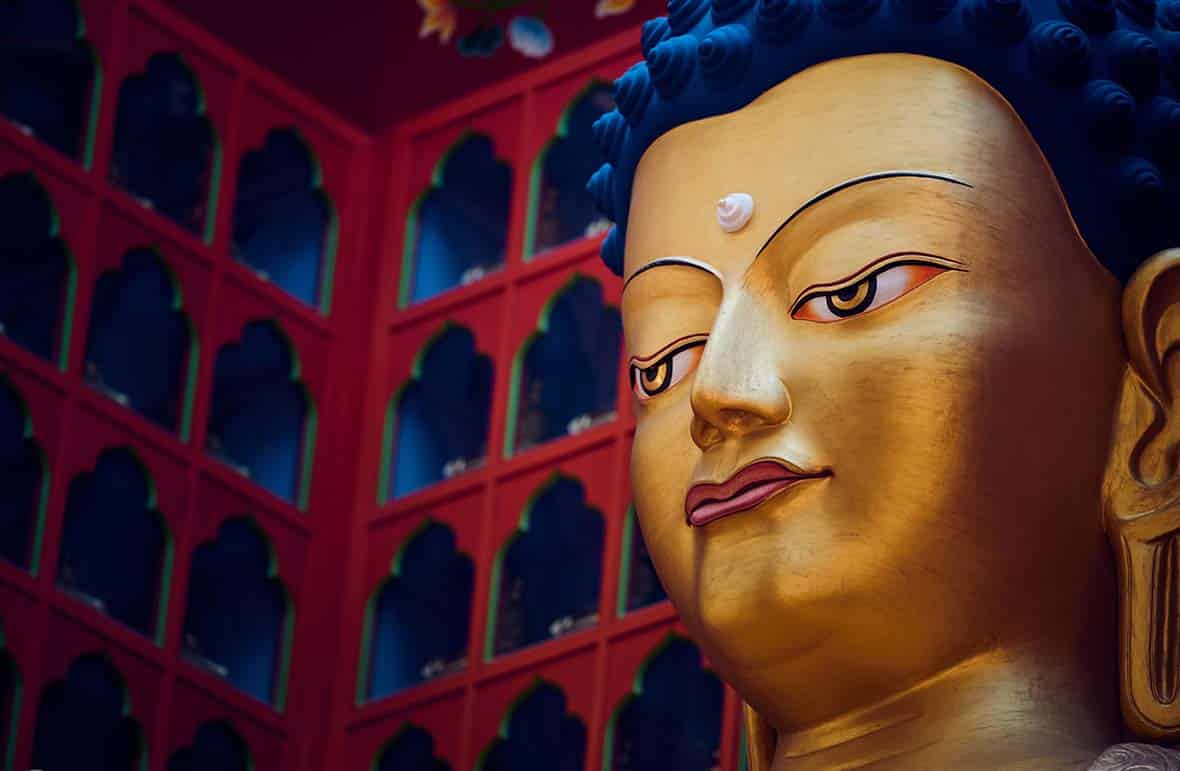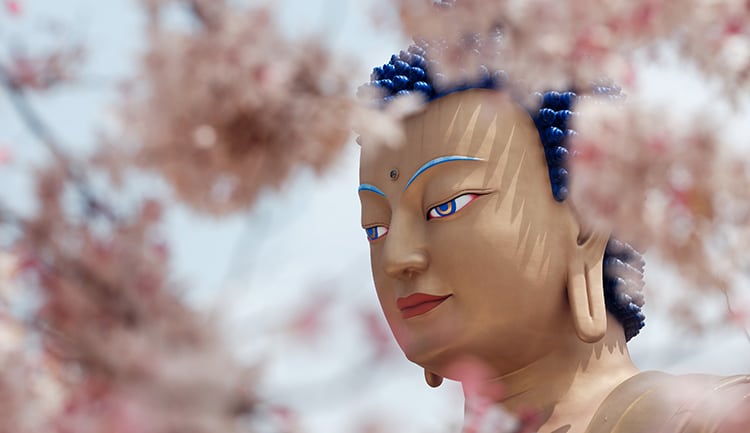The Meaning of Taking Refuge
Category: Buddhist Path | Mind Trainer Articles

Seeking refuge and protection from suffering with the 3 jewels
Taking refuge is a fundamental Buddhist practice. It may be considered the initial practice because it signifies that we want to engage with Buddhism. We have in some way decided that Buddhism is the set of tools, if you like, that we want to live by. Taking refuge is a practice and it’s also an attitude. It’s something we cultivate. It’s also something we can express, as there are verses we recite that convey this sense of taking refuge. But first of all, there’s this rather curious term: “taking refuge.”
Like so many of the terms that we come across in Buddhism, this is what the early translators back in the 19th century came up with. Then it became “official” and we’re stuck with it. “Taking refuge,” to my ear, has a peculiar Victorian tone about it—it’s slightly panicky, one might say, but we’re stuck with it. And actually, the Sanskrit and Tibetan terms that are being translated here do suggest that we’re asking for refuge, we want protection. In Buddhism, this fundamental act is called “taking refuge in the Three Jewels:” the Buddha, his teachings, and the community of those who put his teachings into practice. There’s definitely a sense that you are developing a relationship, a connection with them. You want to practice the Buddhist teachings because you want to be protected. What from? Well, bluntly, suffering, which ranges from relatively minor agitation to full-blown suffering.
I like to put it this way: it’s as if we’re taking refuge because we feel there’s something not quite right in the way we relate to and experience the world. Something’s out of joint. It may be nothing more than a sense of: What’s it all about? What have I been doing here? What am I using or not using this life for? Or maybe it’s more pressing: we’ve looked into the heart of darkness and know we need protection from that. We’re looking to Buddhism because we feel that there’s something to regulate, to make right, and at the same time, we’re not completely capable of making it right by ourselves.
That’s important. It’s a very tricky topic because even if you take refuge, even if you look to the Three Jewels for protection, so to speak, and want to follow the Buddha’s advice, Buddhism is going to throw you right back and say you have to make the path work for yourself. Why is that? Because the real protection is actually within you. The real protection, the source of wisdom and everything that you’re seeking is within you. Sometimes the phrase “Buddha nature” is used to describe this innate wisdom.
It seems like a paradox because going for refuge has the appearance of a devotional practice. You regard the Buddha and his life example with great admiration; you take him as the best teacher possible. You take the Buddha’s teaching, his Dharma, as the best instructions for the path of your life. You take the community of women and men who practice as your helpers in this. But finally, fundamentally, they are only a reflection of what is within you: your Buddha nature.
But, we might say, why not go straight to the source and take refuge in our own Buddha nature? Well, unfortunately, just as we can’t see our own face without a mirror, we cannot access that internal wisdom of the Buddha nature without the guidance of Three Jewels: the Buddha, the Dharma or instructions, and the Sangha, or community. That’s why the process begins with the realization: I can’t quite do it on my own yet. I can’t quite make sense of this. I can’t quite sort out my neuroses and my difficulties. Something’s out of joint and I need this help.
And so we go for refuge just like the early followers of the Buddha did. They were people from all kinds of backgrounds, just as we are. Some were householders and some were men and women who wanted to become full-time renunciants. And they all had something in their lives that needed fixing, that made them go to the Buddha because they thought he had something wise and helpful to say. In the practice of taking refuge, we are doing no more than that.
Let’s explore this a little bit more. I’ve already started talking about the motivation of taking refuge as the wish to be protected from suffering. You could initially take refuge by reciting some verses in front of some master or senior person in the Buddhist community and you’d technically be a Buddhist, and that’s not too bad. There’s something positive about that. But really, refuge should be a lifelong practice. Until we’ve recognized our Buddha nature, so to speak, we need to practice taking refuge. In doing so, we’re reminded of our motivation. Yes, there’s a fear aspect, and there’s also an aspect of confidence that we need to develop.
We take refuge in the Three Jewels because there’s something about them, about the Buddha’s teachings, his life, his example, and the examples of women and men we may meet who embody at least some of his qualities that ring true for us. And in the teaching itself, there’s something that stimulates our admiration and a longing to have the qualities that they demonstrate. And finally, by reasoning, by applying our intelligence to the teachings, we develop the certainty that yes, the explanations we find in this about where suffering comes from, how it can be ended, and so on are truly valid. We recognize that intellectually and also experientially.
And that, in a nutshell, is what is meant by “faith” in Buddhism. You may use the word “faith” or prefer the term “confidence,” but in any case, it is never blind. This is really important. You see, what happens when you take refuge in Buddhism, in the Three Jewels, on the basis of admiration and liking will only get you so far. To continue working productively with these tools for the rest of your life you need real, unshakeable confidence. And this confidence can only come from intelligent, critical examination, from taking the thing apart to make sure it really is consistent with your reasoning and experience.
You’ve got fear, you’ve got confidence—what might be another good motivation? Compassion: the feeling that your path is inclusive of others. That whatever goodness you get from your relationship with Buddhism is going to show up for others through your actions and your engagement with the world. If you can go for refuge with these three motivations, fear, confidence, and compassion, then that’s fantastic. But for many people, the incentive to take refuge starts with just one aspect and gradually matures over life. By repeatedly reassessing your motivation, you confirm that the practice of refuge is a valid path to positive change.








